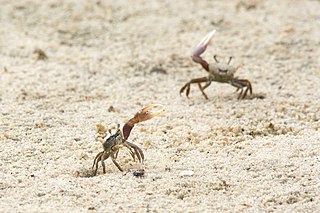
The fiddler crab or calling crab can be one of the hundred species of semiterrestrial marine crabs in the family Ocypodidae. These crabs are well known for their extreme sexual dimorphism, where the male crabs have a major claw significantly larger than their minor claw, whilst females claws are both the same size. The name fiddler crab comes from the appearance of their small and large claw together, looking similar to a fiddle.

The Ocypodidae are a family of semiterrestrial crabs that includes the ghost crabs and fiddler crabs. They are found on tropical and temperate shorelines around the world.

Leptuca pugilator, the sand fiddler crab, Atlantic sand fiddler crab, or Calico fiddler, is a species of fiddler crab that is found from Massachusetts to the Gulf of Mexico. It lives in burrows in coastal and estuarine mud-flats, and can be extremely abundant. It can be differentiated from the morphologically similar Minuca pugnax and Minuca minax by the smoothness of the inside of its claws. One claw is larger than the other, and can be much larger than the crab's body, at up to 41 mm (1.6 in) long.

Austruca perplexa is a species of fiddler crab. It is found from the Ryukyu Islands, Japan to India, throughout the Malay Archipelago, along eastern Australian coasts from Queensland to New South Wales, and in various Pacific islands, including Fiji, Tonga and Vanuatu.

Paraleptuca crassipes or the thick-legged fiddler crab is a species of fiddler crab that lives in intertidal habitats distributed across the western Pacific Ocean.

Minuca minax, commonly known as the red‐jointed fiddler crab or brackish-water fiddler crab, is a species of fiddler crab that is found in the United States from Massachusetts to the Gulf of Mexico. It is one of the most common macroinvertebrates in salt marshes in these states. It prefers areas of lower salinity than other fiddler crabs, and can be found in great numbers along the banks of tidal streams, even at distances greater than 50 km (31 mi) from the sea.

Tubuca urvillei is a species of fiddler crab. It is found in the Southeastern Africa from southern Somalia to the South Africa and Madagascar.

Tubuca alcocki is a species of fiddler crab. Its range includes most of the northern Indian Ocean, from western Thailand, through the Bay of Bengal and India, to the Red Sea.

Tubuca flammula, commonly known as the flame-backed fiddler crab is a species of fiddler crab that is found in the northwest of Western Australia, the northern part of the Northern Territory and the western half of Papua New Guinea

Leptuca panacea, commonly known as the Gulf sand fiddler crab or the Panacea sand fiddler, is a species of fiddler crab native to coastal habitats along the Gulf of Mexico from northwestern Florida to Mexico.
Leptuca speciosa, commonly known as the brilliant fiddler crab or the longfinger fiddler crab, is a species of fiddler crab native to the southern United States, Mexico, and the Caribbean.
Leptuca subcylindrica, commonly known as the Laguna Madre fiddler crab or the puffed fiddler crab, is a sparsely-studied species of fiddler crab native to southern Texas and northeastern Mexico in the Gulf of Mexico.
Leptuca cumulanta, commonly known as the heaping fiddler crab or the mangrove fiddler crab, is a species of fiddler crab native to tropical and subtropical areas of the western Atlantic.

Leptuca uruguayensis, commonly known as the Uruguayan fiddler crab or the southwestern Atlantic fiddler crab, is a species of fiddler crab native to temperate and subtropical areas of the southeastern coast of South America.
Leptuca batuenta, commonly known as the beating fiddler crab, is a species of fiddler crab native to the tropical eastern Pacific, from El Salvador to northern Peru.
Leptuca saltitanta, commonly known as the energetic fiddler crab, is a species of fiddler crab native to the eastern Pacific coasts, from El Salvador in Central America to Colombia in South America.
Leptuca terpsichores, commonly known as the dancing fiddler crab, is a species of fiddler crab native to the eastern Pacific coast of the Americas, from Nicaragua to Peru.

Gelasimus vomeris is a species of fiddler crab found in the southwest Pacific Ocean. In Australia, it is found in the east and north from Darwin to Sydney.

Tubuca polita, commonly known as the polished fiddler crab. or pink-clawed fiddler crab is a species of fiddler crab that is found in the northern part of Australia including the Torres Strait Islands

Tubuca dussumieri, is a species of fiddler crab that is found in the western and south pacific including New Caledonia, Indonesia, Malaysia, Taiwan, Japan, north eastern Australia















